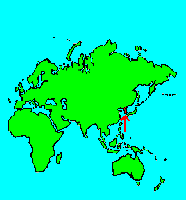SPECIES INFO
Korean mountain ash (Sorbus alnifolia) is found in Japan and Korea. The leaves are not compound. They are simple in this species.Sorbus genus (mountain ash) is a small genus of about 10 to 100 species of trees and shrubs native to the northern temperate zones of the world. (The definition of this genus is the reason for this wide range in counts. Some authors have moved many Pyrus species to this genus.) The alternate pinnately compound leaves help identify the original species in the genus. Although the common names for the original species in this genus contain the word "ash," they are not related to the ash trees. Many of the species in this genus are frequently planted as ornamentals. Kartesz shows 11 species and four subspecies as being established in North America as of 1994.
The species in the Sorbus genus found in the United States are:
Sorbus americana - northeastern USA
Sorbus aucuparia - European escapee
Sorbus californica - Pacific Coast
Sorbus decora - northeastern USA to Greenland
Sorbus domestica
Sorbus dumosa - New Mexico and Arizona
Sorbus groenlandica
Sorbus hybrida
Sorbus sambucifolia
Sorbus scopulina - western United States
Sorbus sitchensis - Yukon to North Carolina
The apple group belongs in the rose family. The genera Malus, Pyrus, and Sorbus belong here. The fruit is a pome (pome: multiple seeds in an internal cavity surround by a fleshy exterior).
Rose Family (Rosaceae) of the Rose Order contains the Rose genus and is a very large diverse family containing not only the roses, but many small weeds and also the important fruit trees including the apple, cherry, pear, and plum. Along with the Grass and Legume Families, this family is one of the most important of all plant groups. There are over 3,000 species in this family organized into over 100 different genera. There are over 840 species growing in greater North America. Typical flowers in this family have five petals and five sepals.
Here the family is divided as follows:
A) Miscellaneous small wild plants such as roses, strawberries, et cetera
B) Rose hybrids of interest to the flower gardener
C) Spiraea group (which forms a natural subfamily)
D) Fruit trees and hawthorns, etceteras (Further redivided)
Crataegeae (Crataegus, Cotoneaster)
Pruneae (Cherries, Plums, Peaches)
Malea (Apples, Pears, Mountain Ash)
Rose Group (Order Rosales) contains many large and very important families. Included here are fruit trees in the family Rosaceae, the nitrogen fixing plants like clover and alfalfa (in the family Leguminosae), and a large assemblage of plants divided into over fifteen different families.
There has been considerable research in recent years as to the organization of the various plant families into orders. Although we certainly recognize and applaud those who are rearranging the families, we are staying with a more traditional approach for several reasons:
1) The traditional approach is well known, and still exists in many very popular field guides.
2) There are questions as to whether the new organizations are finalized.
3) We recognize there are essentially two different modern systems today: A European one and a North American one.
4) Furthermore, we recognize that most plant families and their boundaries are unchanged. In fact many excellent modern books present the families within the Monocots in a simple alphabetical sequence and the families within the Dicots in a simple alphabetical sequence.
Dicots (Dicotyledoneae Class) are the predominant group of vascular plants on earth. With the exception of the grasses (Monocots) and the Conifers (Gymnosperms), most of the larger plants that one encounters are Dicots. Dicots are characterized by having a seed with two outer shell coverings.
Some of the more primitive Dicots are the typical hardwood trees (oaks, birches, hickories, etc). The more advanced Dicots include many of the Composite (Aster) Family flowers like the Dandelion, Aster, Thistles, and Sunflowers. Although many Monocots reach a very high degree of specialization, most botanists feel that the Dicots represent the most advanced group of plants.
Seed plants (Phylum Embryophyta) are generally grouped into one large phylum containing three major classes: the Gymnosperms, the Monocots, and the Dicots. (Some scientists separate the Gymnosperms into a separate phylum and refer to the remaining plants as flowering plants or Angiospermae.)
For North American counts of the number of species in each genus and family, the primary reference has been John T. Kartesz, author of A Synonymized Checklist of the Vascular Flora of the United States, Canada, and Greenland (1994). The geographical scope of his lists include, as part of greater North America, Hawaii, Alaska, Greenland, Puerto Rico, and the Virgin Islands.
Kartesz lists 21,757 species of vascular plants comprising the ferns, gymnosperms and flowering plants as being found in greater North America (including Alaska, Hawaii, Greenland, Puerto Rico and the Virgin Islands.
There are estimates within the scientific world that about half of the listed North American seed plants were originally native with the balance being comprised of Eurasian and tropical plants that have become established.
Plant kingdom contains a large variety of different organisms including mosses, ferns, and seed plants. Most plants manufacture their energy from sunlight and water. Identification of many species is difficult in that most individual plants have characteristics that have variables based on soil moisture, soil chemistry, and sunlight.
Because of the difficulty in learning and identifying different plant groups, specialists have emerged that study only a limited group of plants. These specialists revise the taxonomy and give us detailed descriptions and ranges of the various species. Their results are published in technical journals and written with highly specialized words that apply to a specific group.
On the other hand, there are the nature publishers. These people and companies undertake the challenging task of trying to provide easy to use pictures and descriptions to identify those species.


